About Publications Library Archives
heritagepost.org

Preserving Revolutionary & Civil War History

Preserving Revolutionary & Civil War History
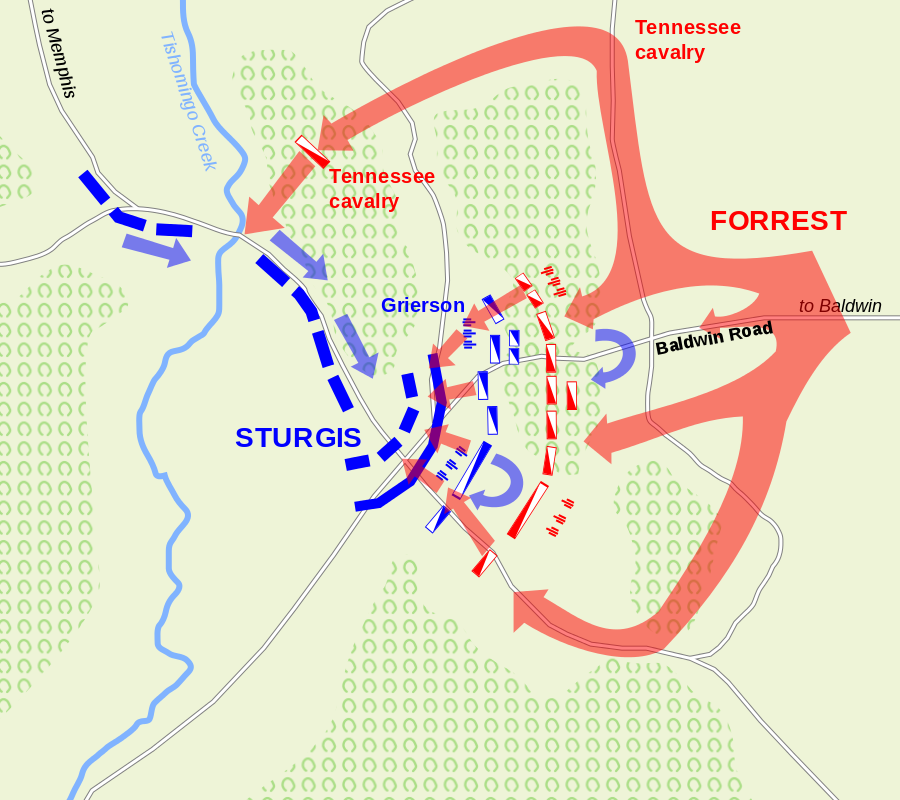
| Battle Name | Brice’s Crossroads |
| Other Names | Tishomingo Creek |
| State | Mississippi |
| Location | Prentiss County and Union County |
| Campaign | Forrest’s Defense of Mississippi |
| Dates | June 10, 1864 |
| Principal Commanders | Brig. Gen. Samuel D. Sturgis [US] ; Maj. Gen. Nathan Bedford Forrest [CS] |
| Forces engaged | Three-brigade division of infantry and a division of cavalry (8,500 est ) [US]; cavalry corps [CS] (4,800 est) |
| Estimated Casualties | 3,105 total (US 2,610; CS 495) |
| Description | At the beginning of June 1864, Maj. Gen. Nathan Bedford Forrest set out with his cavalry corps of about 2,000 men to enter Middle Tennessee and destroy the Nashville & Chattanooga Railroad, which was carrying men and supplies to Maj. Gen. William T. Sherman in Georgia. On June 10, 1864, Forrest’s smaller Confederate force defeated a much larger Union column under Brig. Gen. Samuel Sturgis at Brice’s Cross Roads. This brilliant tactical victory against long odds cemented Forrest’s reputation as one of the foremost mounted infantry leaders of the war. |
Back-story Leading to the Battle
In late winter and early spring of 1864, Union General William Tecumseh Sherman began preparations to pursue Confederate General Joseph Johnston out of Tennessee and down through Georgia to Atlanta. Mindful of the threats to his lengthening supply lines, Sherman decided to lure out the remaining organized Confederate troops in the region to destroy them, securing his rear and flanks, and then strike at Johnston to his front.
Confederate troops to the west of Sherman’s advance were under the overall command of Lt. General Stephen Lee. His immediate subordinate and main field commander was Major General Nathan Bedford Forrest, a soldier whose effectiveness in leading hit and run strikes on Union garrisons and supply depots was without peer. Forrest was not a professional soldier, having no military training prior to the Civil War. He amassed a fortune in antebellum Mississippi as a slave trader and highly successful planter. As one of the wealthiest men in the South when the Civil War began in 1861, he enlisted as a private with the Tennessee Mounted Rifles. When that unit experienced difficulty equipping itself, Forrest offered his own money to purchase horses, weapons, uniforms, and all the necessary accouterments of a modern military unit of the time.
By mid-1861 Forrest was commissioned as a Lieutenant Colonel by the Confederate state of Tennessee and authorized to create and equip a regiment which became known as Forrest’s Cavalry Corps. Forrest and his command were one of the units besieged by General Ulysses S. Grant at Fort Donelson in 1862, from which they successfully broke out, eluding capture when the fort surrendered. From that time until early 1864, he developed a fearsome reputation among the Union troops who opposed him, striking hard and fast at points previously considered safe from Confederate attack. Due to the successes Forrest’s men had achieved in previous raids on Sherman’s supply lines, they were more heavily armed than the cavalry units Union troops normally encountered, with both repeating rifles and revolvers they had pillaged from Union supply dumps.
Forrest also developed the reputation of being a great leader from the men who served with him. He had been wounded at the Battle of Shiloh and served with the main Confederate Army at the Battle of Chickamauga, where he led the pursuit of the defeated Union army, turning an orderly retreat into a rout and capturing hundreds.
Forrest recognized the catastrophic effect on the Confederate’s overall military position should Sherman succeed in driving Johnston into a siege around Atlanta. He recognized as well the vulnerability of Sherman’s position, deep in enemy territory. Severing the supply lines would prevent any forward movement of Sherman’s columns, offering Forrest an opportunity to defend Atlanta without confronting the main body of Sherman’s army.
In the early spring of 1864, Sherman detached a body of about 8,500 men at Memphis, Tennessee, with orders to neutralize Forrest’s much smaller command and secure the Union rear. These troops, combining cavalry, infantry, and artillery, were placed under the command of Brigadier General Samuel Sturgis, an experienced combat commander and a member of the famed West Point class of 1846, which had also produced Thomas “Stonewall” Jackson, Jeb Stuart, A.P. Hill, George McClellan, and George Pickett. Sherman ordered Sturgis to strike into northern Mississippi to find Forrest, engage him, and destroy the troops under his command.

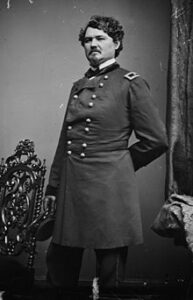
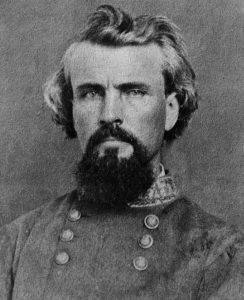
On April 30th, Sturgis set out from Memphis with two infantry brigades and a cavalry division headed by Brigadier General Benjamin Grierson. Forrest was known to be in Jackson, Tennessee, gathering men and supplies, and Sturgis was tasked with keeping him from escaping back into friendly territory in Mississippi. However, spies had alerted Forrest of the activity, and after skirmishes with a few regiments of Sturgis’ men, he was able to slip back into Mississippi. Sturgis pursued him for a while, but on May 9th, short on supplies, he returned to Memphis in failure.
Once back in Mississippi, Forrest convinced General Lee that he could make a successful raid on the Nashville & Chattanooga Railroad, Sherman’s main supply line. Lee agreed to the idea, and on June 1, 1864, sent Forrest and 2,000 men from Harrisburg, Mississippi, towards the rail line in middle Tennessee. In the meantime, Sturgis launched a second attempt to defeat Forrest, departing Memphis in the direction of Tupelo, Mississippi. Forrest had made it to Russellville, Alabama when Lee learned of the new attempt by Sturgis to track him down. Lee immediately recalled Forrest, and on June 9th they met in Boonesville, Mississippi, to figure out their next move.
With Forrest before him, but refusing to engage, Sturgis moved towards Tupelo slowly, averaging less than ten miles per day. Meanwhile, Lee directed Forrest to consolidate with his own troops in the vicinity of Okolona, Mississippi, but in doing so gave the more aggressive Forrest the opportunity to “act at discretion,” meaning Forrest had wide latitude to operate in accordance with the events occurring before him, rather than move towards the rendezvous at Okolona.
Instead of withdrawing towards Okolona, Forrest decided to attack the advancing Union force, which outnumbered him by about two to one, along the banks of Tishomingo Creek near an intersection of four dirt roads known as Brice’s Crossroads, named for the owner of a house at the intersection, William Brice. The terrain which he chose for the attack was heavily wooded, and although the early June heat of the Deep South had taken hold, the spring muds had not yet hardened in the roads.
Forrest’s scouts revealed to him the nature of the Union advance. Sturgis’s cavalry, still commanded by Grierson, was advancing several hours ahead of the infantry, which needed to move at the pace of the much slower artillery and support train. Although Sturgis was an experienced combat commander and his troops were veterans, this placed the cavalry in serious jeopardy if they were to come under attack. Sturgis believed that the numerical superiority he enjoyed would prevent Forrest from taking the initiative, other than by hit and run attacks, which is why his cavalry was deployed entirely in his front.
While the Confederates would be outnumbered if all Union troops were on hand, they outnumbered Grierson’s isolated cavalry 4,800 to 3,300. If Forrest could defeat the cavalry, he could then move on to fight the rest of Sturgis’s army on more even terms. He also knew that a heavy attack on his opponent’s cavalry would force the Union general to rush his infantry forward, in oppressive heat and on muddy, miry roads, over several miles. By the time the Union infantry reached the battlefield, the heat and Mississippi mud would have exhausted them. Forrest could then use Tishomingo Creek, which the Union troops would have to cross to reach the battlegrounds, as a trap to keep them from escaping. The creek, normally shallow enough to walk across without really getting one’s feet wet, ran through a gully no more than twenty feet wide, but there was only one bridge by which troops and wagons could get back across and withdraw from the field.
The Battle of Brice’s Crossroads
Early in the morning on June 10, 1864, the Union cavalry’s foremost advanced unit led by Colonel George Waring moved down Baldwyn Road and met with 800 Confederates from Kentucky under Colonel Hylan Lyon. Outnumbered, Lyon’s men fell back towards the rest of their unit. Waring feared that a larger Confederate force was on the way and thus dismounted and formed a battle line across the road one-half mile east of the crossroads. By this time, late in the war, cavalry usually deployed for battle by dismounting and forming line abreast rather than attacking in the classic charge. They could thus be deployed quickly on horseback, dismount, and be in a position to counter both infantry or cavalry attacks from a defensive position with heavy firepower. However, this weakened the cavalry in numbers since about one-quarter of the unit would be required to tend to the horses of the men on the front line.
Waring was soon joined by Colonel Edward Winslow’s and General Grierson’s men, and the resulting battle line stretched north to south for over one mile. Grierson immediately sent riders back to Sturgis, who was then about three to four hours behind with the infantry, asking for support, informing him that he “had an advantageous position and could hold it if the infantry was brought up promptly.”
Lyon’s men also formed a line, and by 10 AM they were joined by Forrest. Though not all Confederate cavalry had arrived, Forrest began the first two of three attacks, a frontal assault and an attack on the Union left flank, both of which were repulsed. By noon all of his men had arrived, giving him three brigades on the battlefield. The Confederates now outnumbered the Union cavalry by over 1,000 men. Forrest then launched a third attack, this time breaking through the enemy line and sending the Union troops retreating westward to about one-quarter of a mile from the crossroads, where they formed a second line of defense.
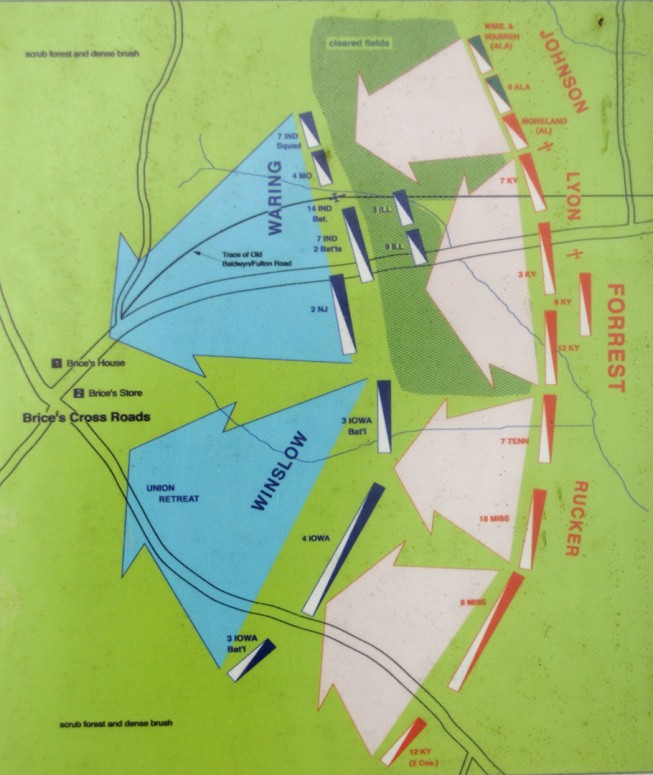
The first of the Union infantry arrived at the battlefield around one o’clock in the afternoon, bolstering the new defensive line set up by the cavalry. Along with them came over 250 supply wagons, all of which crossed the bridge at Tishomingo Creek. This decision would later prove disastrous for the Union army.
Sturgis had now arrived on the battlefield and repositioned his lines, anticipating the arrival of the rest of his infantry, after which he would have sufficient strength to attack and destroy Forrest’s cavalry. In the meantime, the Union lines under Colonels George Hoge and Alex Wilkins were able to temporarily stop a massive Confederate assault that began around 2 PM.
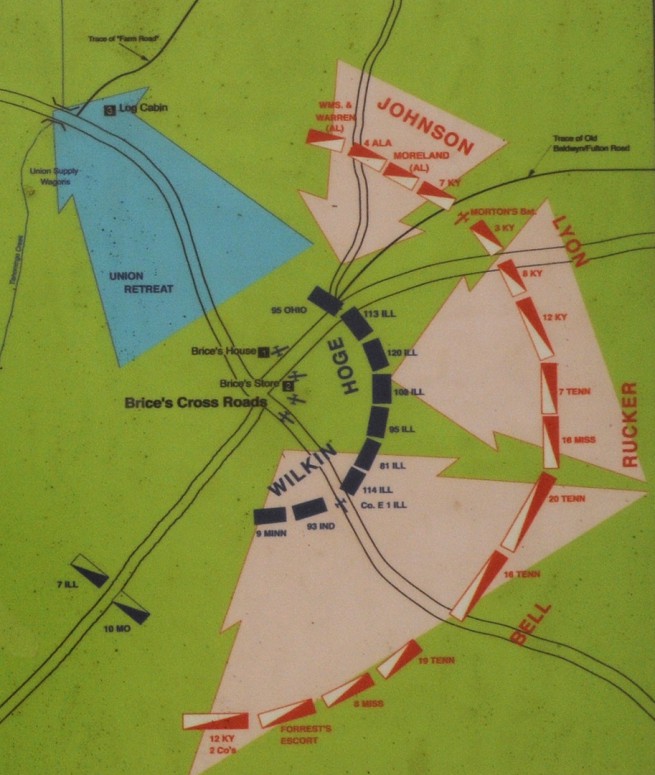
By 4 PM the Confederates had regrouped and were ready to mount one final attack, this time with artillery at the forefront. Forrest also sent his 2nd Tennessee Cavalry under Colonel Clark Barteau to get behind the enemy line and assault and capture the Tishomingo Bridge. If the Confederates captured the bridge, the Union forces would have been split, with the force already across the creek cut off from escape. The assault on the bridge saw the day’s fiercest fighting, with the 2nd Tennessee repulsed by overwhelming Union numbers. Most of the casualties suffered by Forrest’s troops occurred during this phase of the battle. However, units that could have helped the main Union line at the crossroads were drawn into the fight with Barteau, so while the attack on the bridge was unsuccessful, it did help in the overall battle with Union troops.
The late afternoon attack by the Confederate artillery devastated the 113th Illinois Infantry, which turned and ran. Troops under Colonel Edmund Rucker rushed into the hole created by the fleeing infantry and the Union line soon collapsed. Aware of the danger of having half of his force trapped with its back to the creek, Sturgis ordered a retreat while the Union still retained possession of the bridge. As the exhausted Union troops withdrew in relatively good order they found themselves bottled up by the 250 supply wagons that were also attempting to get back across the creek.
Forrest then ordered a general assault, with artillery commanded by Captain John Morton opening fire on the retreating soldiers from a ridge above the creek, and the orderly withdrawal soon deteriorated into a panicked rout. Men ditched their weapons as they plunged across the creek. The waters, normally low enough to wade through without a problem, had been swollen by previous rain, and many men were washed downstream and drowned. Only Union Colonel Bouton’s colored troops and the remaining men from Winslow’s cavalry stood and fought, giving many of the Union soldiers time to cross the creek.
The Confederate cavalry, now mounted, began a punishing pistol and saber attack, and the Union units broke and ran for safety. As they fell back they encountered the still advancing remainder of Sturgis’s infantry that had not yet reached the battlefield. Rather than providing a defense line on which the defeated Union troops could rally, these units joined in the panic, incited, no doubt, by the rampaging Confederate Cavalry and the unnerving Rebel yell.
Confederate artillery also pursued the fleeing Union soldiers. Unlike standard artillery units, the ones attached to General Forrest’s cavalry were “horse artillery.” All members of the gun crew had their own horses and rode into battle on them, making them much faster and mobile than standard artillery units. In fact, at one point the Union soldiers turned to make a stand and General Forrest ordered an artillery charge unaided by infantry or cavalry. Such a charge was unheard of, but Captain Morton followed the order, charging to within 60 feet of the Union line before opening fire. This immediately scattered the enemy and they never turned back. The Union panic did not cease until the remnants of Sturgis’s command reached Memphis, nearly fifty miles from the Brice’s Crossroads battlefield.
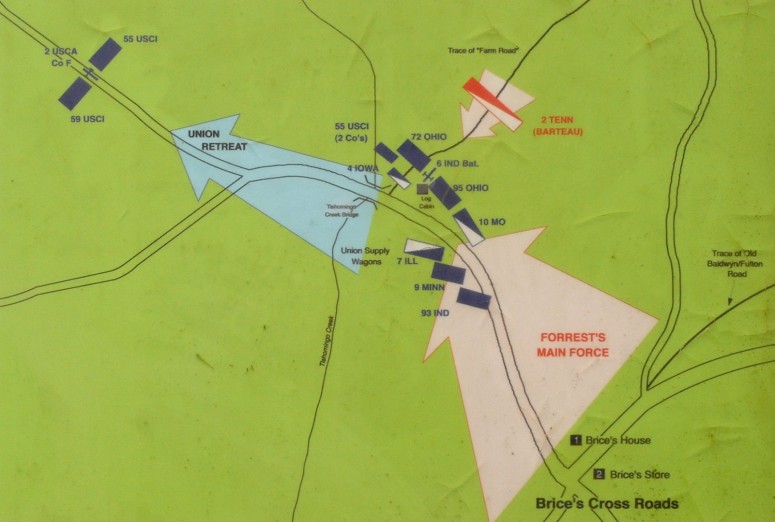
The victorious Confederates suffered just under 500 total casualties, the Union army over 2,200, including nearly 1,600 men taken prisoner. Forrest’s troops, in defeating an army more than twice their strength, seized 15 pieces of artillery, nearly 200 mules and horses, nearly 200 wagons, 15,000 small arms, and 300,000 rounds of small-arm ammunition, all of which was left behind in the general rout.
The battle was a tactical masterpiece by an amateur soldier over a professional one, and the outraged Sherman was forced to reconsider his advance towards Atlanta as long as Forrest remained in the field. Sherman blamed Sturgis for the defeat, which ended Sturgis’s Civil War service for all intents and purposes. Rumors in the eastern newspapers blamed the debacle on the Union commander being drunk the night before Forrest launched his attack, a rumor which was later proven to be untrue. Sturgis would go on to serve as commander of the 7th Cavalry in the Sioux Indian Wars; his Lt. Colonel was George Armstrong Custer. Sturgis was absent of his command on official business when Custer led part of the regiment into battle at Little Big Horn. The city of Sturgis, South Dakota, was named for him.
Sherman was forced to send a second force to eliminate the threat to his supply lines created by Forrest; this expedition met with more success at the Battle of Tupelo, although it did not eliminate Forrest’s Cavalry Corps entirely. Forrest remained in the field with the steadily dwindling Confederate armies until hearing of Lee’s surrender at Appomattox, at which time Forrest too surrendered to the Union armies in Alabama in May 1865